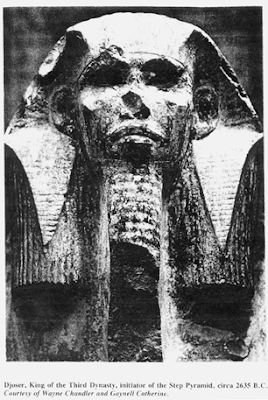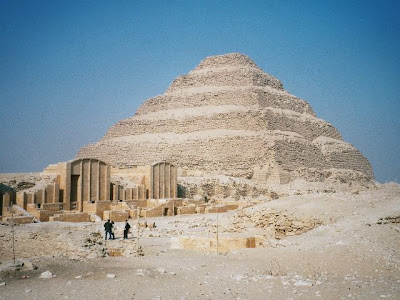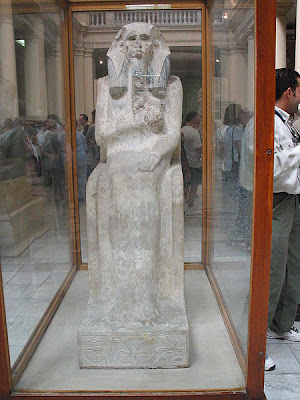


Netjerikhet or Djoser (Turin King List "Dsr-it"; Manetho "Tosarthros") is the best-known pharaoh of the Third dynasty of Egypt. He commissioned his official, Imhotep (ca. 2650-2600 BC), to build the first of the pyramids, a step pyramid for him at Saqqara. Variants of his name include Zoser, Dzoser, Zozer, Dsr, Djeser, Djésèr, Horus-Netjerikhet, and Horus-Netjerichet.
Though there is significant controversy about dating the reigns of the Old Kingdom, The Third Dynasty is conventionally placed in the 27th century BC, with Djoser's reign roughly in the period ca 2635 to 2610 BC.
The painted limestone statue of Djoser, now in the Egyptian Museum in Cairo, is the oldest known life-sized Egyptian statue. Today at the site in Saqqara where it was found, a plaster copy of the statue stands in place of the original. The statue was found during the Antiquities Service Excavations of 1924-1925.
In contemporary inscriptions, he is called Netjerikhet, meaning "body of the gods." Later sources, which include a New Kingdom reference to his construction, help confirm that Netjerikhet and Djoser are the same person.
While Manetho names Necherophes and the Turin King List names Nebka as the first ruler of the Third dynasty, many Egyptologists now believe Djoser was first king of this dynasty, pointing out that the order in which some predecessors of Khufu are mentioned in the Papyrus Westcar suggests Nebka should be placed between Djoser and Huni, not before Djoser. More significantly, the English Egyptologist Toby Wilkinson has demonstrated that burial seals found at the entrance to Khasekhemwy's tomb in Abydos name only Djoser, rather than Nebka. This supports the view that it was Djoser who buried, and hence directly succeeded, Khasekhemwy, rather than Nebka.
Reign length
Manetho states Djoser ruled Egypt for twenty-nine years, while the Turin King List states it was only nineteen years. Because of his many substantial building projects, particularly at Saqqara, some scholars argue Djoser must have enjoyed a reign of nearly three decades. Manetho's figure appears to be more accurate, according to Wilkinson's analysis and reconstruction of the Royal Annals. Wilkinson reconstructs the Annals as giving Djoser "28 complete or partial years", noting that the cattle counts recorded on Palermo Stone register V, and Cairo Fragment 1 register V, for the beginning and ending of Djoser's reign, would most likely indicate his regnal Years 1-5 and 19-28.
Reign
Djoser dispatched several military expeditions to the Sinai Peninsula, during which the local inhabitants were subdued. He also sent expeditions there to mine for valuable minerals such as turquoise and copper. This is known from inscriptions found in the desert there, sometimes displaying the banner of Seth alongside the symbols of Horus, as had been more common under Khasekhemwy. The Sinai was also strategically important as a buffer between the Nile valley and Asia.
His most famous monument was his step pyramid, which entailed the construction of several mastaba tombs one over another. These forms would eventually lead to the standard pyramid tomb in the later Old Kingdom. Manetho, many centuries later, alludes to architectural advances of this reign, mentioning that "Tosorthros" discovered how to build with hewn stone, in addition to being remembered as the physician Aesculapius, and for introducing some reforms in the writing system. Modern scholars think that Manetho originally ascribed (or meant to ascribe) these feats to Imuthes, who was later deified as Aesculapius by the Greeks and Romans, and who corresponds to Imhotep, the famous minister of Djoser who engineered the Step Pyramid's construction.
Some fragmentary reliefs found at Heliopolis and Gebelein mention Djoser's name and suggest he commissioned construction projects in those cities. Also, he may have fixed the southern boundary of his kingdom at the First Cataract. An inscription known as the Famine Stela and claiming to date to the reign of Djoser, but probably created during the Ptolemaic Dynasty, relates how Djoser rebuilt the temple of Khnum on the island of Elephantine at the First Cataract, thus ending a seven-year famine in Egypt. Some consider this ancient inscription as a legend at the time it was inscribed. Nonetheless, it does show that more than two millennia after his reign, Egyptians still remembered Djoser.
Although he seems to have started an unfinished tomb at Abydos (Upper Egypt), Djoser was eventually buried in his famous pyramid at Saqqara in Lower Egypt. Since Khasekhemwy of the 2nd dynasty was thus the last pharaoh ever to be buried at Abydos, some Egyptologists infer that the shift to a more northerly capital was completed during Djoser's time.
Family
Because Queen Nimaethap, the wife of Khasekhemwy, the last king of the Second dynasty of Egypt, is mentioned on a jar sealing of Khasekhemwy with the title "Mother of the King's children", some writers argue she was Djoser's mother and Khasekhemwy was his father. This is also suggested by another jar sealing, dating to Djoser's reign, calling her "Mother of the King of the Two Lands". Her cult seems to have still been active in the later reign of Sneferu.
Hetephernebti is identified as one of Djoser's queens "on a series of boundary stela from the Step Pyramid enclosure (now in various museums) and a fragment of relief from a building at Hermopolis" currently in the Egyptian museum of Turin.[4]
Inetkawes was their only daughter known by name. There was also a third royal female attested during Djoser's reign, but her name is destroyed. The relationship between Djoser and his successor, Sekhemkhet, is not known, and the date of his death is uncertain



ليست هناك تعليقات:
إرسال تعليق